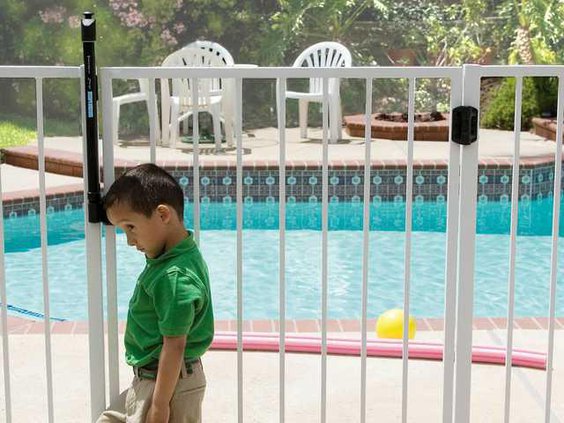Enjoy the pleasures of home pool ownership and ensure a safer summer for your family by employing a few safety measures around your pool.
One way to do this is to integrate Safer 3, an initiative of the Swim for Life Foundation, which calls for “Safer Water, Safer Kids and Safer Response.”
Swim lessons and supervision lead to safer kids. Having family members take classes in CPR and implementing measures like keeping a portable phone by the pool can help you make a safer response. To ensure safer water, install layers of protection between the home and the pool.
Parents watch their children, especially during the toddler stages, but it’s impossible to watch them every second of every day. There are times when a parent is distracted by cooking, doing laundry, checking email, showering or other activities. Many caregivers turn TV or a video on inside the house, and ensure children are watching. But kids get easily distracted, and water draws them like a magnet.
Water safety experts say that safer water is achieved by having layers of protection in place between your home and pool, to buy the time to re-establish contact after a momentary distraction. Studies in areas where isolation fencing is mandatory, such as Western Australia, have proven that isolation fencing with self-closing, self-latching gates saves lives. Isolation fencing separates the pool from the home, either surrounding the pool or enclosing all doors leading from the home, to prevent children who get out the door from traveling beyond the patio. For above-ground pools, a smaller fence and gate surrounding the steps or ladder can prevent toddler access.
“If a child gains unauthorized access to a pool and drowns, it’s a terrible tragedy,” says D&D Technologies’ Senior Vice President Jim Paterson. “It can also be a liability issue when the injured party is a visitor. You can improve the safety and security of your pool or spa with isolation fencing with self-closing, self-latching gate hardware.
“D&D’s MagnaLatch is the No. 1 selling child safety gate latch in the world,” Paterson adds. “Unlike common gravity latches, MagnaLatch helps create ‘peace of mind’ by utilizing permanent magnet technology to ensure there is no friction or resistance to closure. It has a built-in key lock, eliminating the need for a separate padlock. It won’t jam, is self-latching and vertically and horizontally adjustable for ease of maintenance. Our gate hardware is formed of super-strong engineering polymers with stainless steel components, so it won’t rust - ever, and it carries a limited lifetime warranty. With TruClose hinges, no external closing spring is required, and the homeowner can easily adjust hinge tension to ensure gate closure after installation with a screwdriver.”
Paterson notes that rust-free gate hardware is now available under the Stanley or National Hardware brand through select Lowe’s stores or online at www.lowes.com, and through other hardware retailers or fencing professionals. The hinges and latches are simple to install and most models offer vertical and horizontal adjustment to correct gate misalignment caused by ground movement, children swinging on gates or other factors.
Pool barrier codes require pool gates to be self-closing and self-latching, and to open away from the pool. D&D has two lockable MagnaLatch styles so the release can be mounted at the code-required height, typically 54 or 60 inches above the ground. Consult your building department for local regulations.
Pool safety advocacy groups like the National Drowning Prevention Alliance (NDPA) recommend that homeowners utilize several layers of protection so they can experience the pleasures of swimming pools and feel an added degree of assurance that their children, grandchildren and visitors will be safe.
The dangers of suction drain entrapment are also significant, and anti-entrapment drain covers should be in place. Pool professionals should be consulted to ensure the correct suction entrapment prevention devices are used.
Both the Safer 3 and the NDPA recommend that a “water watcher” be designated for safety when children are in the pool, to maintain eye-to-eye contact at all times.
Toys or floating chlorine dispensers that look like toys should never be left in the pool area.
“With isolation fencing and the Safer 3 in place, your family can look forward to years of relaxation and enjoyment of your pool,” Paterson says.
For more information, visit www.ddtechglobal.com or www.ndpa.org. For a free Pool Safety Kit call (800) 716-0888, ext. 292, or email info@ddtechusa.com.
Pool safety measures for a safer summer




